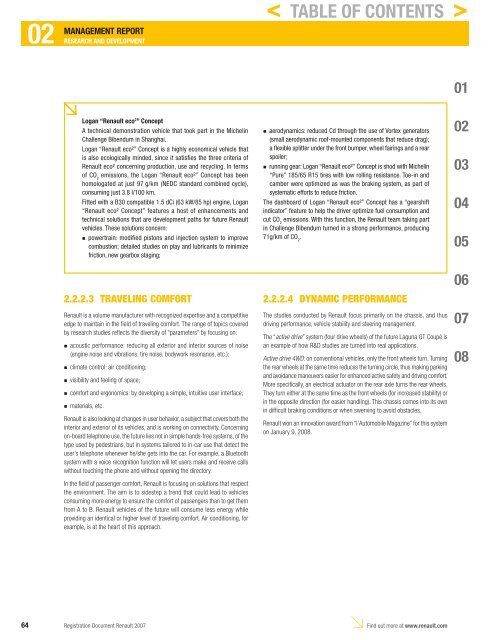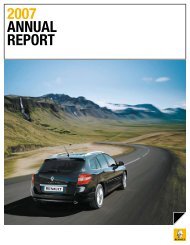2007 Interactive Registration Document - Renault
2007 Interactive Registration Document - Renault
2007 Interactive Registration Document - Renault
You also want an ePaper? Increase the reach of your titles
YUMPU automatically turns print PDFs into web optimized ePapers that Google loves.
02 RESEARCH<br />
MANAGEMENT REPORT<br />
AND DEVELOPMENT<br />
2.2.2.3 TRAVELING COMFORT<br />
<strong>Renault</strong> is a volume manufacturer with recognized expertise and a competitive<br />
edge to maintain in the fi eld of traveling comfort. The range of topics covered<br />
by research studies refl ects the diversity of “parameters” by focusing on:<br />
n<br />
n<br />
n<br />
n<br />
n<br />
Logan “<strong>Renault</strong> eco2 ” Concept<br />
A technical demonstration vehicle that took part in the Michelin<br />
Challenge Bibendum in Shanghai.<br />
Logan “<strong>Renault</strong> eco²” Concept is a highly economical vehicle that<br />
is also ecologically minded, since it satisfi es the three criteria of<br />
<strong>Renault</strong> eco² concerning production, use and recycling. In terms<br />
of CO emissions, the Logan “<strong>Renault</strong> eco²” Concept has been<br />
2<br />
homologated at just 97 g/km (NEDC standard combined cycle),<br />
consuming just 3.8 l/100 km.<br />
Fitted with a B30 c ompatible 1.5 dCi (63 kW/85 hp) engine, Logan<br />
“<strong>Renault</strong> eco² Concept” features a host of enhancements and<br />
technical solutions that are development paths for future <strong>Renault</strong><br />
vehicles. These solutions concern:<br />
n powertrain: modified pistons and injection system to improve<br />
combustion; detailed studies on play and lubricants to minimize<br />
friction, new gearbox staging;<br />
acoustic performance: reducing all exterior and interior sources of noise<br />
(engine noise and vibrations, tire noise, bodywork resonance, etc.);<br />
climate control: air conditioning;<br />
visibility and feeling of space;<br />
comfort and ergonomics: by developing a simple, intuitive user interface;<br />
materials, etc.<br />
<strong>Renault</strong> is also looking at changes in user behavior, a subject that covers both the<br />
interior and exterior of its vehicles, and is working on connectivity. Concerning<br />
on-board telephone use, the future lies not in simple hands-free systems, of the<br />
type used by pedestrians, but in systems tailored to in-car use that detect the<br />
user’s telephone whenever he/she gets into the car. For example, a Bluetooth<br />
system with a voice recognition function will let users make and receive calls<br />
without touching the phone and without opening the directory.<br />
In the fi eld of passenger comfort, <strong>Renault</strong> is focusing on solutions that respect<br />
the environment. The aim is to sidestep a trend that could lead to vehicles<br />
consuming more energy to ensure the comfort of passengers than to get them<br />
from A to B. <strong>Renault</strong> vehicles of the future will consume less energy while<br />
providing an identical or higher level of traveling comfort. Air conditioning, for<br />
example, is at the heart of this approach.<br />
< TABLE OF CONTENTS ><br />
n aerodynamics: reduced Cd through the use of Vortex generators<br />
(small aerodynamic roof-mounted components that reduce drag);<br />
a fl exible splitter under the front bumper, wheel fairings and a rear<br />
spoiler;<br />
n running gear: Logan “<strong>Renault</strong> eco²” Concept is shod with Michelin<br />
“Pure” 185/65 R15 tires with low rolling resistance. Toe-in and<br />
camber were optimized as was the braking system, as part of<br />
systematic efforts to reduce friction.<br />
The dashboard of Logan “<strong>Renault</strong> eco²” Concept has a “gearshift<br />
indicator” feature to help the driver optimize fuel consumption and<br />
cut CO emissions. With this function, the <strong>Renault</strong> team taking part<br />
2<br />
in Challenge Bibendum turned in a strong performance, producing<br />
71g/km of CO . 2<br />
2.2.2.4 DYNAMIC PERFORMANCE<br />
The studies conducted by <strong>Renault</strong> focus primarily on the chassis, and thus<br />
driving performance, vehicle stability and steering management.<br />
The “ active drive” system (four drive wheels) of the future Laguna GT Coupé is<br />
an example of how R&D studies are turned into real applications.<br />
Active drive 4WD: on conventional vehicles, only the front wheels turn. Turning<br />
the rear wheels at the same time reduces the turning circle, thus making parking<br />
and avoidance maneuvers easier for enhanced active safety and driving comfort.<br />
More specifi cally, an electrical actuator on the rear axle turns the rear wheels.<br />
They turn either at the same time as the front wheels (for increased stability) or<br />
in the opposite direction (for easier handling). This chassis comes into its own<br />
in diffi cult braking conditions or when swerving to avoid obstacles.<br />
<strong>Renault</strong> won an innovation award from “l’Automobile Magazine” for this system<br />
on January 9, 2008.<br />
64 <strong>Registration</strong> <strong>Document</strong> <strong>Renault</strong> <strong>2007</strong><br />
Find out more at www.renault.com<br />
01<br />
02<br />
03<br />
04<br />
05<br />
06<br />
07<br />
08




